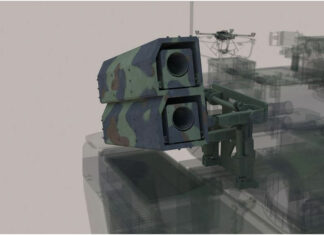An update on the Merkava based Infantry Fighting Vehicle
“For 38 years we produced only tanks, but in the last two years we have expanded into a family of vehicles, with the development and production of the Namer IFV.” Brigadier general Yaron Livnat, Merkava Tank Program Manager (PM) told Defense Update. “The Mk 4 entered service four years after its development started. The development of the Namer began in 2007, and by mid-2010, a mere three years later, it is under full-rate production, with sufficient number of vehicles supplied, to equip several infantry battalions.” The Namer is based on the basic technology of the Merkava, but is actually a completely new vehicle concept. These differences already became evident from our visit to the production line, where many vehicles of the two types filled the various work stations and final assembly lines, sharing the same manufacturing facilities, previously used exclusively for Merkava Mk 4 production process.
Designed to carry a full infantry squad and a crew of three, Namer not only keeps pace accompanying the tanks in battle, in fact it is faster, more agile, maneuverable and protected, compared to the Merkava Mk 4. Handling the roughest terrain, ranging from the mountainous, rocky Golan Heights and Southern Lebanon, to the sand dunes of the Negev and Sinai desert, Namer also offers a level of protection that exceeds any other vehicle in its class. Namer uses a 1,200 hp powerpack already used in the Merkava. It also retains the high-performance suspension and automotive systems, developed by Ashot Ashkelon for the Merkava, enabling uncompromised mobility in rough terrain. Its internal and external design is modular and versatile, accommodating different mission-kits, as they are being introduced.
The Namer family of vehicles will comprise two sub-groups – fighting vehicles and combat support vehicles. Among the fighting vehicles are the infantry carriers, currently in production, a command vehicle having the same silhouette, but internally configured to work as forward command post, and a weapon carrier, modeled with an overhead unmanned weapon station, carrying guided missiles and a medium caliber automatic 30mm gun or the 120mm CARDOM mortar. The combat support group will include a medical evacuation vehicle, technical support vehicle, recovery vehicle and an engineering support vehicle. Eventually, Namer derivatives will replace many different vehicles, currently in service, including the Puma engineering vehicle, based on the long, old Centurion tank chassis, the Achzarit infantry carriers based on modified T-55s and under-protected M-113s still employed in different combat support roles.
At present, Namer is produced in the infantry fighting vehicle configuration, equipped with a stabilized remotely operated weapon station produced by Rafael advanced defense systems. Multiple display computers are delivered by Nir-Or Systems, providing the crew and passengers full situational awareness, under armor protection. Overpressure filtration and air conditioning system made by Kinetics render life support, in harsh environmental conditions and under chemical or biological attacks. A fire-suppression system supplied by Spectronics is also part of the vehicle’s survivability package. The forward located power- pack, characteristic of the Merkava, adds to the crew protection in the frontal arc. All- around, advanced, modular hybrid armor, provides high level protection, against all types of threats. “The weight saved by eliminating the turret was ‘reinvested’ in beefing up the armor” Livnat explained, “this has resulted, with Namer having better protected from belly charges and IEDs, than any other armored vehicle”. This becomes an important life-saving asset, in case the vehicle hits roadside or under belly IED. The armor suite uses a modular format, which is already designed to accommodate an active protection system (APS), planned to be installed in the future. The ‘Iron Fist’, currently under development at IMI, is being considered for the Namer. Providing a stand-off interception of incoming projectiles and missiles, Iron Fist will offer a hemispherical protection from threats fired from close-range and extended range alike.



















